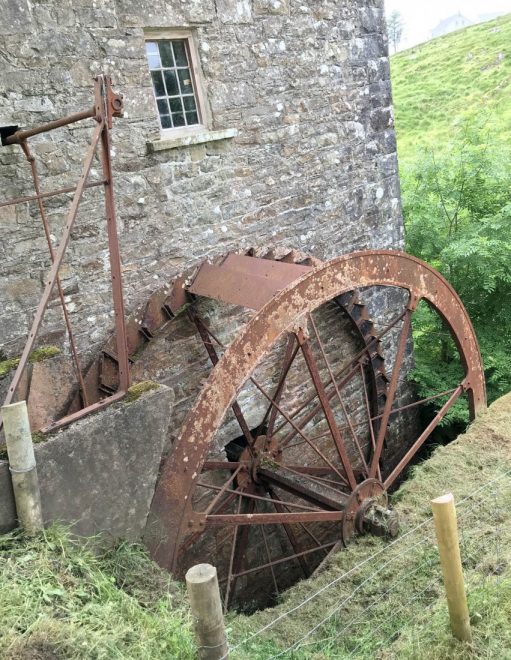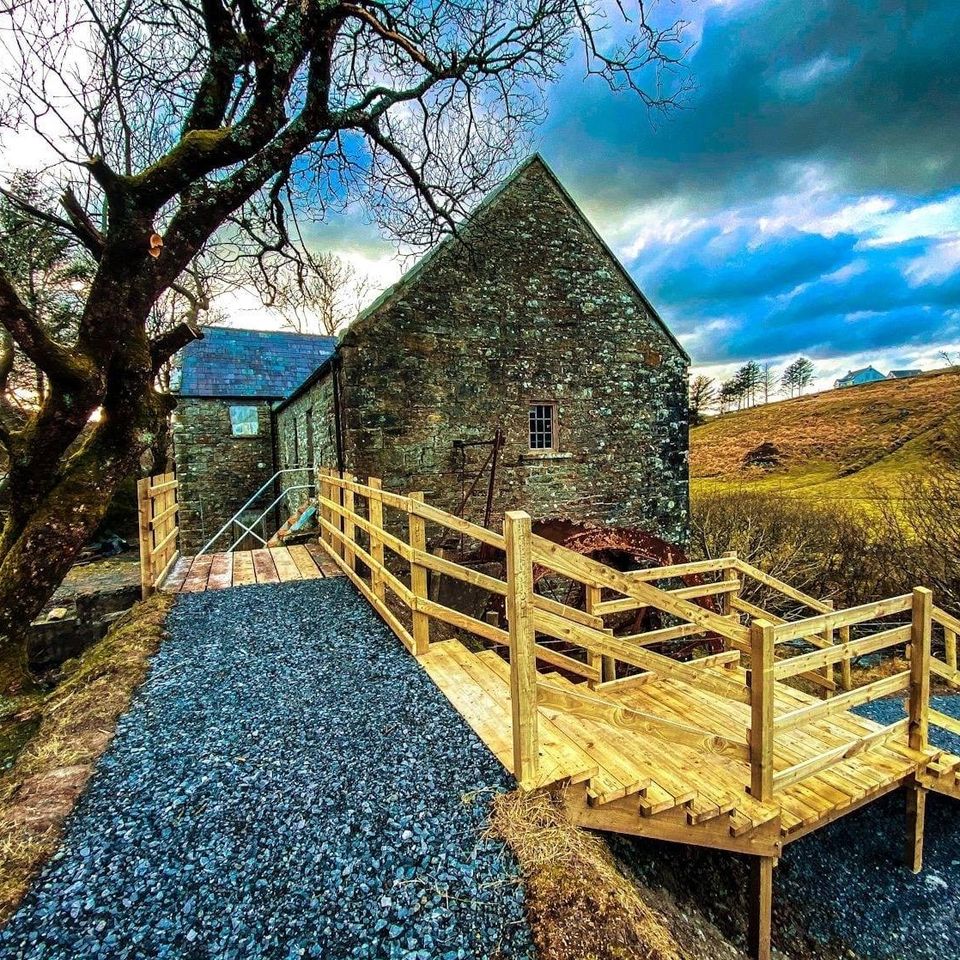
THE construction of a €250,000 car park and access route is underway as part of the Leitir Corn Mill Conservation Project.
It is the latest phase of ambitious plans to re-develop a working heritage mill.
Construction on the car park should be completed this September allowing work to commence on rebuilding the mill-wheel and repairing the internal machinery.
Dating back to the early 19th century, the mill located on the Glenaddragh river in Kilcar, catered for the corn growers of the parishes of Kilcar, Glencolmcille and Killybegs.
Farmers from parts of Ardara also travelled to the mill to have their corn ground into oatmeal.
The Leitir Corn Mill Conservation Project was launched in 2015 and was divided into five phases.
The stabilization of the mill and drying kiln buildings and the development of a river walk have been completed while the car park forms phase three.
Rebuilding the mill-wheel and repairing the internal machinery and refurbishing the 19th century miller’s cottage to include café and souvenir shop make up the final phases.
The Leitir Corn Mill Conservation and Restoration Project is one of the largest projects undertaken in the parish in recent times.
The owner Michael Ward has donated the mill and miller’s house on a long-term lease to the community along with a field which is being developed into the car park.
Last week, Mr Ward, chairperson, joined Tom Glynn (secretary) and Martina O’Donnell (treasurer) in showing off the corn-drying kiln and corn mill at Leitir.
LATE 1700s
The site is brimming with local history and the two-storey mill is built of stone from south-west Donegal. It dates back to the late 1700s and was refurbished around the famine time and refurbished again in 1862 when the new kiln and machinery, which came from the Stevenson foundry in Strabane, were installed.
“HG Murray Stewart was landlord at time (1862) and the stone masons, the Campbells, were local. The builder was McMunn from Killybegs and the work was overseen by Stewart’s land agent, GB Wilson.
“The new mill was ready for the 1864-65 milling season which ran from October until the following March/April. The first miller was McDevitt from Inver but he only stayed a year before Johnny McMullan came from Bruckless. His father ran the Oily Mill in Bruckless and their family would have come from the Fintona area of Tyrone. His son Peter bought the mill from Musgraves in 1913. Peter and his two brothers had a good construction business going a the time. They built schools on Arranmore and in Fanad while they also did a lot of work around Omagh and Limavady,” Michael Ward explained.
“At the time, millers were never usually mentioned in Griffith’s Valuation unless they were paying rent or rates on a property. Neil McLoone, a businessman in Killybegs, was the renter in 1867 before Musgraves took over in 1878. Peter (McMullan) bought the mill in 1913. Initially he wanted his brother James Josie to work the mill but he died within six months of his father in 1919 and he ended up taking it on until his own death in November 1953.
“My father (Columba) then stepped in. His mum was a niece of the miller and he knew what to do but, in fairness, it was on its last legs and according to his diary there was only 188 bags milled between March and May 1954,” he said.
While traditional mills received a big boost during the war years, shops by then had stocks of fine white flour and with people gravitating towards flour the old mill ceased trading.
Although it has remained closed for the past 67 years, few of Ireland’s traditional corn mills have survived to the present day with the level of preservation and intactness of Leitir Corn Mill thanks to Mr Ward.
“My father, who used to collect for Norwich Union, went to work for the ESB after running the mill for a year but he always ensured that the mill was maintained down through the years,” Mr Ward added.
As part of the conservation project, the mill and kiln roof has been replaced, using as much as possible of the original blue Bangor slates. New floors were installed in the kiln loft and milling floor while windows and lintels were replaced or refurbished.
The wood and stone flag floor of the kiln head pit floor was replaced to its original condition; new stairs were installed in the kiln and the beams in the mill were refurbished where necessary. The miller’s house was also re-roofed.
“The corn-drying kiln and corn mill at Leitir is undoubtedly of regional significance. This site is an important part of the 19th century industrial heritage of not alone Kilcar, but of the county and entire north-west region,” Mr Glynn said.
The committee is now welcoming donations from groups, companies and individuals.
The new river walk, repair of the head race, mill dam, race sluices and associated landscaping was completed with the aid funding from FLAG (BIM) €35,000 and L.A.W.P €5,730.
The groups also received LEADER -Údarás na Gaeltachta funding of €183,424 towards the new car park while they have also secured a Bridging Loan from WDC (Western Development Committee) of €75,000.
Through its Facebook page – leitircornmill, the group have set up a GoFundMe page and have a PAYPAL link on the page.
Through the Website – leitircornmill.com they have set up a Donate Button for PAYPAL. They are also doing a Bucket Collection on Saturday July 31st.
“We will also be selling raffle tickets for a 4 prizes 1st prize €500, 2nd Prize €300 3rd and 4th Prize €100 – one ticket €10 or book of three for €20.
“We will be asking for people to renew their subscription with ‘Friends of the Mill’. This was introduced some years ago during Heritage Week. €20 per membership / €30 for family with 3 free admission to mill.
“The mill will offer the visitor a unique glimpse of an era when country mills flourished, and for the winter and early spring at least, plied its trade and served farming communities.
It survives as a rare example of the small country custom mill, dedicated to grinding the farmer’s hard won corn harvest into the finest oatmeal. The associated miller’s house and the millrace and millpond along with the scenic walk will further enhance the visitor experience,” Ms O’Donnell said.
The site is brimming with local history and the two-storey mill is built of stone from south-west Donegal. It dates back to the late 1700s and was refurbished around the famine time and refurbished again in 1862 when the new kiln and machinery, which came from the Stevenson foundry in Strabane, were installed.
“HG Murray Stewart was landlord at time (1862) and the stone masons, the Campbells, were local. The builder was McMunn from Killybegs and the work was overseen by Stewart’s land agent, GB Wilson.
“The new mill was ready for the 1864-65 milling season which ran from October until the following March/April. The first miller was McDevitt from Inver but he only stayed a year before Johnny McMullan came from Bruckless. His father ran the Oily Mill in Bruckless and their family would have come from the Fintona area of Tyrone. His son Peter bought the mill from Musgraves in 1913. Peter and his two brothers had a good construction business going a the time. They built schools on Arranmore and in Fanad while they also did a lot of work around Omagh and Limavady,” Michael Ward explained.
“At the time, millers were never usually mentioned in Griffith’s Valuation unless they were paying rent or rates on a property. Neil McLoone, a businessman in Killybegs, was the renter in 1867 before Musgraves took over in 1878. Peter (McMullan) bought the mill in 1913. Initially he wanted his brother James Josie to work the mill but he died within six months of his father in 1919 and he ended up taking it on until his own death in November 1953.
“My father (Columba) then stepped in. His mum was a niece of the miller and he knew what to do but, in fairness, it was on its last legs and according to his diary there was only 188 bags milled between March and May 1954,” he said.
While traditional mills received a big boost during the war years, shops by then had stocks of fine white flour and with people gravitating towards flour the old mill ceased trading.
Although it has remained closed for the past 67 years, few of Ireland’s traditional corn mills have survived to the present day with the level of preservation and intactness of Leitir Corn Mill thanks to Mr Ward.
“My father, who used to collect for Norwich Union, went to work for the ESB after running the mill for a year but he always ensured that the mill was maintained down through the years,” Mr Ward added.
As part of the conservation project, the mill and kiln roof has been replaced, using as much as possible of the original blue Bangor slates. New floors were installed in the kiln loft and milling floor while windows and lintels were replaced or refurbished.
The wood and stone flag floor of the kiln head pit floor was replaced to its original condition; new stairs were installed in the kiln and the beams in the mill were refurbished where necessary. The miller’s house was also re-roofed.
“The corn-drying kiln and corn mill at Leitir is undoubtedly of regional significance. This site is an important part of the 19th century industrial heritage of not alone Kilcar, but of the county and entire north-west region,” Mr Glynn said.
The committee is now welcoming donations from groups, companies and individuals.
The new river walk, repair of the head race, mill dam, race sluices and associated landscaping was completed with the aid funding from FLAG (BIM) €35,000 and L.A.W.P €5,730.
The groups also received LEADER -Údarás na Gaeltachta funding of €183,424 towards the new car park while they have also secured a Bridging Loan from WDC (Western Development Committee) of €75,000.
Through its Facebook page – leitircornmill, the group have set up a GoFundMe page and have a PAYPAL link on the page.
Through the Website – leitircornmill.com they have set up a Donate Button for PAYPAL. They are also doing a Bucket Collection on Saturday July 31st.
“We will also be selling raffle tickets for a 4 prizes 1st prize €500, 2nd Prize €300 3rd and 4th Prize €100 – one ticket €10 or book of three for €20.
“We will be asking for people to renew their subscription with ‘Friends of the Mill’. This was introduced some years ago during Heritage Week. €20 per membership / €30 for family with 3 free admission to mill.
“The mill will offer the visitor a unique glimpse of an era when country mills flourished, and for the winter and early spring at least, plied its trade and served farming communities.
It survives as a rare example of the small country custom mill, dedicated to grinding the farmer’s hard won corn harvest into the finest oatmeal. The associated miller’s house and the millrace and millpond along with the scenic walk will further enhance the visitor experience,” Ms O’Donnell said.
Posted: 9:00 am July 19, 2021










